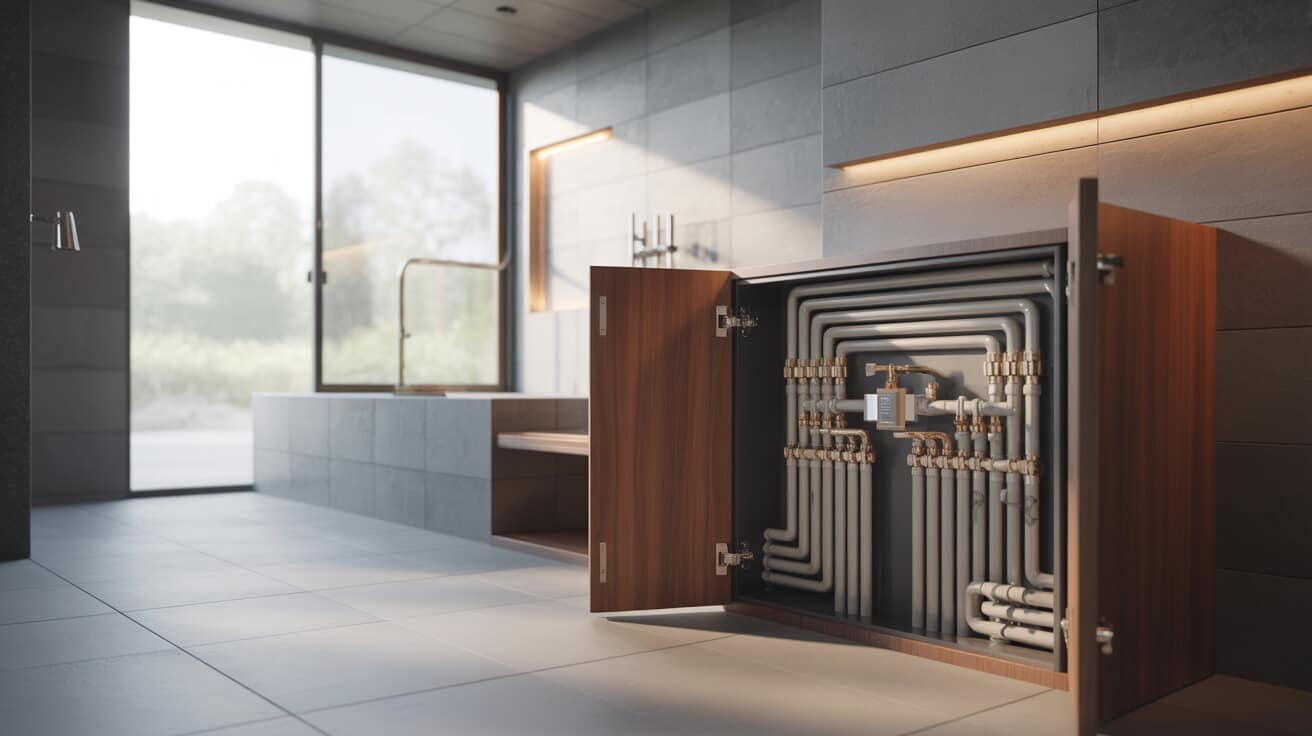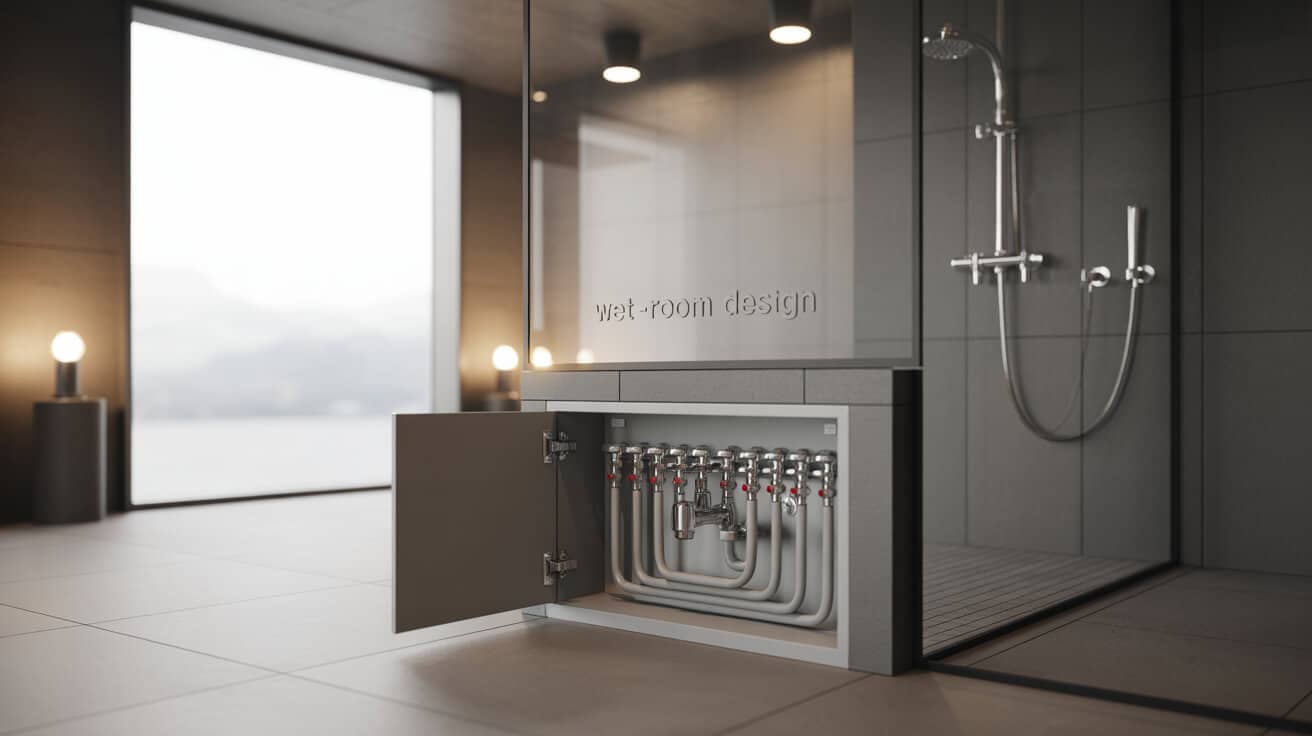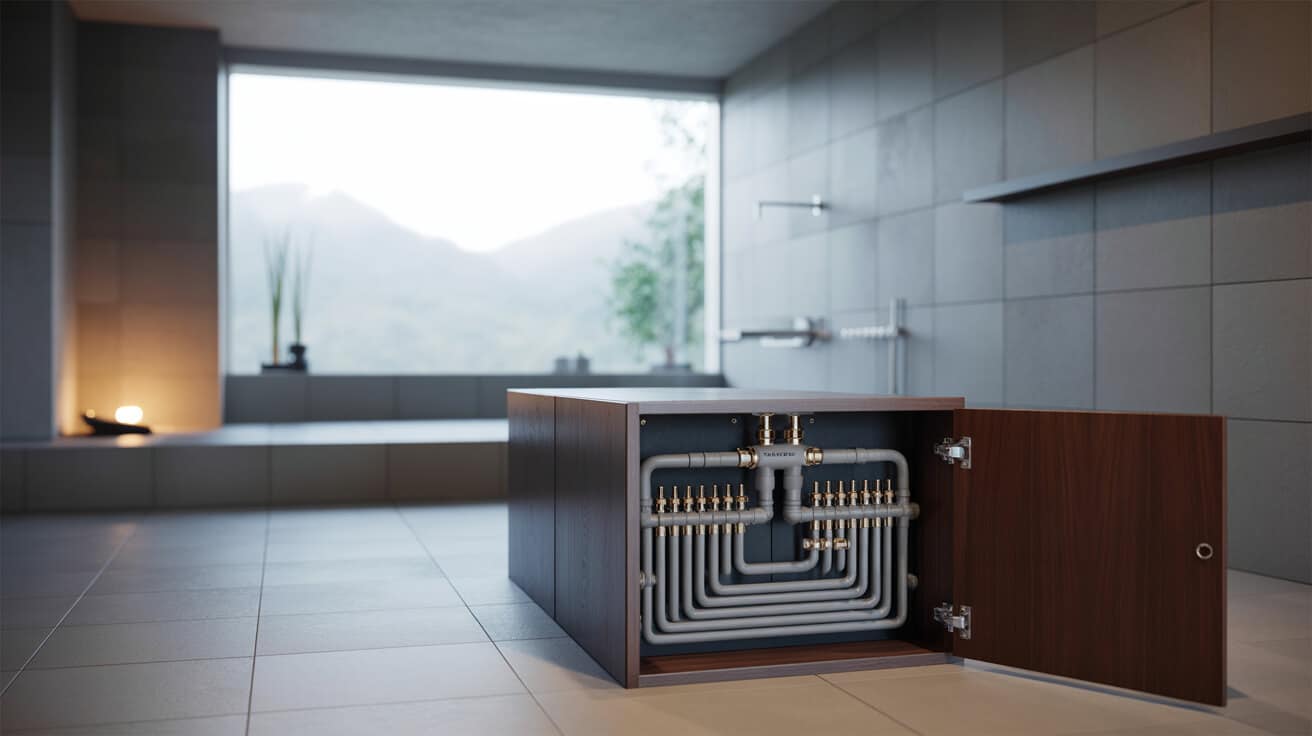An underfloor heating manifold installation is a phased technical process that orchestrates the precise delivery of heat to specific zones throughout a property. Manifold systems, constructed from materials such as brass, stainless steel, or advanced polymer composites, allow for individualised thermal control, lower running costs, and unparalleled heating uniformity. By enabling granular control of floor heat, the manifold transforms routine heating into a scalable, responsive solution, harmonising with renewable heat sources, modern smart controls, and multi-zonal regulatory requirements. The success of a heating project, and the satisfaction of your property’s users, depend on both the technical rigour of the installation and the clarity of post-installation support.
Etymology or name origin
The word “manifold” derives from mechanical engineering, where it describes a device that collects or distributes fluids through multiple channels from a unified source. In the context of radiant heating, a manifold is a distribution node that enables the routing of heated water across a web of circuits, each serving an autonomous zone. This multiplicity mirrors the etymological root—”many folds”—evoking the branching logic and organisational clarity the manifold brings to advanced plumbing and heating design.
Overview / context
System role and environment
Underfloor heating systems have redefined comfort aspirations in both residential and commercial spaces by eliminating cold spots, minimising energy loss, and sustaining even warmth at the human level. The manifold occupies a unique niche within this evolution, bridging the gap between the heat producer—be it a condensing boiler, air source heat pump, or solar thermal array—and numerous flexible, floor-level delivery zones. Your building’s demands for multi-room, programmable comfort, and sustainability targets, have driven the manifold’s centrality in professional heating design.
Market, user, and property trends
- Increasing market penetration in high-performance housing, premium apartment developments, educational and care facilities, and energy-conscious refurbishments.
- Requirements for zone-specific scheduling, remote monitoring, and record retention have catalysed demand for robust, maintainable manifold systems.
- Enhanced thermal performance, alongside compliance with energy codes, forms the basis of multi-stakeholder, long-term decision-making across property portfolios.
History
Origins and ancient systems
Early approaches to whole-space heating emerged in the Roman hypocaust, using subfloor ducts and stone slabs, and in East Asian architectures such as Korea’s ondol, utilising wood-fired channels to temper stone floors. These antecedents demonstrate the longstanding desire to create distributed, even heat beneath occupied zones.
Transition to modern construction
The 20th-century advent of plastic piping materials (PEX, polybutylene) and hydraulic modelling enabled the evolution from single-loop “serpentine” underfloor systems to multi-zone, multi-circuit arrangements. The arrival of the manifold, able to manage complex distribution and maintenance needs, marked a pivotal step for both installers and building owners.
Emergence of standardised manifold designs
Rapid innovation in the late 20th and early 21st centuries produced modular manifolds with integrated flow metres, balancing valves, digital actuators, and isolation units. This standardisation, paralleled by advances in heat source controls and system integration, provided a foundation for companies such as Plumbers 4U to guarantee consistent outcomes and legal compliance across property classes.

Concept / description
Component parts
An underfloor heating manifold consists of dual-chambered bars (supply and return), each equipped with ports for circuit connection. Key features typically include:
- Flow metres: Crucial for real-time visual and quantitative flow adjustment.
- Balancing valves: Allowing tailored hydraulic calibration per circuit.
- Isolation valves: Supporting zone-by-zone servicing and maintenance with minimal interruption.
- Drain/fill taps: Ensuring safe pressure testing, filling, and system flushes.
- Actuators: Electric or wax-thermally driven, facilitating digital, programmable zone control.
- Mounting brackets and enclosures: Designed for easy access, safety, and aesthetic concealment.
- Temperature and pressure gauges: Ongoing operational feedback for owners and facilities teams.
Principles of operation
The manifold operates as a switchboard, orchestrating how much warm water is delivered to each room or zone. The balancing valves ensure hydraulic parity, preventing under- or over-servicing of specific circuits, while actuators translate thermostat signals into flow modulation.
Zoning and circuit logic
By segmenting floor areas into independent zones, property owners achieve:
- Multi-room scheduling (enhanced comfort and cost control)
- Targeted heating (warmth where, and when, it’s most needed)
- Single-zone isolation for maintenance, upgrade, or emergency purposes.
Functionality / purpose / applications
The manifold elevates underfloor heating from a blunt tool to a precision climate solution. Its applications span:
- Domestic properties: Enabling whole-house comfort, energy budgeting, and smart home integration.
- Commercial settings: Managing high-occupancy or multi-use environments, such as open-plan offices, schools, and care homes, where targeted control is mandatory.
- Retrofit and renovations: Allowing for efficient heating solutions without compromising existing layouts and aesthetics.
Key benefits extend to:
- Consistent, draught-minimised warmth regardless of season.
- Energy savings via dynamic adaptation, particularly in properties seeking to harmonise old and new construction.
- Streamlined maintenance and diagnostics, essential for minimising costly, disruptive interventions.
Classifications / types / variants
Hydronic vs electric underfloor heating
- Hydronic (water-based): Utilises a manifold for multiple circuits, suited for larger or more complex properties due to efficiency.
- Electric: Employs resistive cables or mats; lacks a central manifold, designed for simpler or single-zone implementations.
Material and construction variants
- Brass manifolds: Exceptional service life and hydraulic integrity; ideal for commercial and premium residential projects.
- Stainless steel: Corrosion- and scale-resistant, balancing durability and cost.
- Polymer/composite: Lightweight, modular, suitable for smaller-scale or cost-sensitive installations.
Manual vs automatic controls
- Manual: Traditional balancing and isolation features, adjusted by field engineers.
- Automatic: Integrated with electronic actuators and zoning systems, responding to property automation and programming.
| Manifold Type | Durability | Zone Support | Cost | Best For |
|---|---|---|---|---|
| Brass | High | Many | Higher | Complex/multi-zone |
| Stainless Steel | High | Many | Medium | Commercial/domestic |
| Polymer/Composite | Moderate | Limited | Lower | Small/retrofit projects |
Installation methodology
Assessment and planning
Careful design starts with a property heat loss survey, usage analysis, and consultation regarding your property’s layout, occupancy schedules, and regulatory context. Correct circuit sizing, manifold location, and integration strategy emerge from this baseline.
Positioning and fixing
A manifold should be positioned for access, concealment, and hydraulic efficiency. Structural mounting is performed using engineered brackets; correct elevation and orientation ensure air venting and drainage capability.
Assembly and pipe connection
All pipes, labelled per zone and length, are routed with minimization of joints and bends to preserve both hydraulic flow and long-term reliability. Connections utilise WRAS-approved compression or press-fit fittings, tested in stages to prevent early leakage.
Testing, balancing, commissioning
- Pressure test: Proves closed-circuit integrity prior to floor covering.
- System flush: Removes debris and introduces inhibitor to prevent corrosion and limescale.
- Balancing: Performed circuit-by-circuit, ensuring design flow rates are met.
- Functional testing: Each actuator is exercised alongside all thermostats and control elements prior to sign-off.
Documentation and client handover
Comprehensive end-user packs, containing as-fitted schematics, warranty certificates, and a maintenance roadmap, are delivered at handover. Plumbers 4U exemplifies best practice by providing direct support contacts, a log of initial readings, and digital storage of key documentation for your reference.

Systems / tools / methodologies
Manual and power tools
Professional installations depend on:
- Pipe cutters
- Hydraulic crimping tools
- Pressure test pumps (manual and digital)
- Manifold spanners
- Thermal imagery devices
The careful calibration and use of these tools underlies every successful project, whether installed on a new build timeline or retrofit schedule.
Installation approaches and controls
Projects are staged between first-fix (pipe laying, insulation, and testing embedded prior to screeding) and second-fix phases (manifold commission, thermostat/control wiring, functional checks). Advanced integration with wireless thermostats facilitates centralised, zone-based adjustments even after full occupancy.
Testing and diagnostic equipment
High-resolution thermal imaging and digital flow metres allow for non-invasive QC (quality control), supporting faster troubleshooting and verification. Remote monitoring and data-logging capabilities inform building managers of early warning signs and maintenance needs.
Suppliers and brands
Leading suppliers for UK and European projects include:
Your installation partner’s capacity to source, integrate, and service these brands underpins both initial performance and long-term reliability.
Stakeholders / entities involved
Customer and property personas
- Homeowners: Value the fusion of comfort, zoned control, and efficiency.
- Landlords: Balance compliance needs and heating infrastructure longevity, minimising tenant disruption.
- Facilities managers: Prioritise system reporting, remote management, and servicing predictability.
- Commercial developers: Include manifold solutions as features in high-value and green-certified developments.
Professional and regulatory roles
- Installers and engineers: Carry design/build liability, execute to WRAS, Part L, and BS EN 1264 standards.
- Project managers and compliance auditors: Validate integration into other building systems, provide warranty sign-off, and retain documentation.
- Suppliers/manufacturers: Ensure product conformity, supply technical support, and maintain professional training schedules.
Legal / regulatory / ethical considerations
Legal frameworks and codes
- Part L (energy efficiency): Specifies design, documentation and KPIs that must be met by the system.
- Part G (sanitation): Protects water supply safety; mandates anti-backflow measures, particularly for multi-user properties.
- BS EN 1264: Lays out principles governing heat distribution, pipework, and system longevity.
- WRAS approval: Products in contact with drinking water systems require certification.
Professional qualification and service documentation
Only NVQ Level 3 certified engineers, ideally partnered with WaterSafe and TrustMark, should conduct installations. All systems should be supplied with a Benchmark logbook, as-built diagrams, and a service schedule.
Warranty, handover, and aftercare
Your protection relies on the clarity and completeness of system documentation and the quality of the handover. Plumbers 4U supports all client instals with digital backups, ongoing service reminders, and warranty consultation—the foundation for asset protection and tenant satisfaction.
Performance metrics / data / measurements
Key indicators
- Target flow rates and uniformity: Each circuit demonstrates design specification compliance.
- Supply-return temperature delta: Monitored monthly; informs on operational efficiency and hydraulic imbalances.
- Surface warmth calibration: Uses digital thermometry to confirm zone parity and support predictive maintenance.
Measurement and reporting protocols
- Balancing logs and as-fitted readings are maintained for warranty, audit, and future upgrades.
- Building managers and owners may access cloud-stored or printed KPI reports for evidence to insurers and compliance officers.
- Annual/biannual checks by certified engineers include thermal imaging, pressure assessment, actuator and zone test cycling.
Challenges / barriers / limitations
Operational and technical issues
Retrofit installations risk disruption, unplanned costs, and misalignments due to existing subfloors or unpredictable historic layouts. Legacy heat sources may struggle to supply the lower-temperature flow rates required for full efficiency.
Social and economic factors
The cost of installation is higher than for standard radiator setups, although lifecycle savings can be pronounced. Occupied buildings require phased, often out-of-hours, installation to minimise user disruption. The high degree of customization means that system upgrades can be complex, especially in poorly documented older properties.
Additional barriers
Gaps remain in workforce competency, especially relating to commissioning and after-instal handover. Customers not provided with complete documentation may be left facing warranty or insurance uncertainty years later, especially if switching service providers.
Impact / influence / legacy
Sector and property impact
Widespread uptake of underfloor heating manifolds has recalibrated customer expectations for heating comfort, system longevity, and maintainability. These systems are now referenced as gold-standard attributes in both new construction and high-value retrofits.
Downstream effects and value creation
- Increase in regular, predictable service contracts (reducing asset risk).
- Evolution of documentation and record-keeping as a compliance and sales tool, especially for larger property portfolios.
- Higher minimum standards for technical training, building quality, and permitted heating system architectures.
Ongoing relevance for stakeholders
As market trends, legislative demands, and customer aspirations continue to evolve, the manifold’s relevance is continuously enhanced by smart device integration, renewable energy compliance, and the expectation for transparent, service-backed ownership.
Future directions, cultural relevance, and design discourse
Sustainability and technology alignment
Manifold development and application is closely aligned with UK and EU decarbonisation mandates. Low-temperature operation, paired with heat pump and solar thermal sources, represents the next leap in energy-efficient comfort for discerning property owners and asset managers.
Industry and professional shifts
The rise of advanced control systems, machine learning-based zoning, and automated diagnostics promises to further empower facilities teams and homeowners, enabling even more granular comfort-control, predictive maintenance, and regulatory compliance. The refinement of professional practice, from digital commissioning to asset-linked warranty administration, will benefit both clients and installers.
Cultural status
No longer a luxury reserved for high-end homes, underfloor heating—anchored by robust manifold technology—has entered the mainstream, marking the convergence of performance engineering, building physics, and the everyday comfort expectations of you and your organisation. Its presence increasingly signals a commitment to sustainability, technical excellence, and a higher standard of living.

